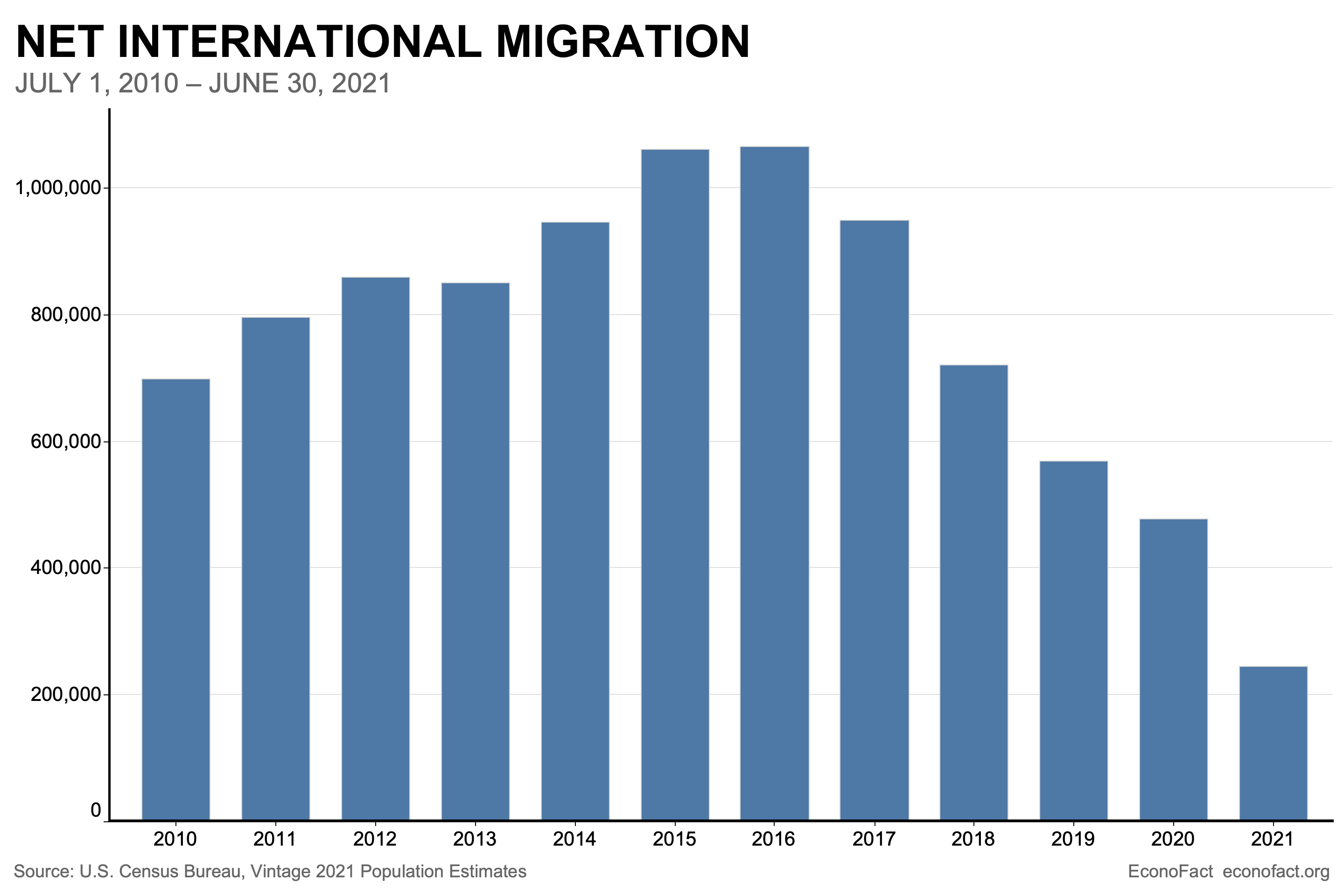The Decline in U.S. Net Migration
Williams College and the Brookings Institution
The Issue:
About 45 million foreign-born people currently live in the United States, making up about 14 percent of the U.S. population — a share that is just below the fraction of immigrants living in the United States around the turn of the twentieth century, when immigration was at its previous historic high. But net migration to the United States, the change in the number of foreign-born residents, has significantly declined over the last five years due to policies of the Trump administration, processing backlogs, the pandemic, and other factors. This slowdown has implications for the number of workers available and for fiscal sustainability at a time when the national debt relative to GDP is the highest it has been since World War II.
Reductions in net immigration to the U.S. began prior to the pandemic, declining in every year since 2016, when net migration exceeded one million.
The Facts:
- The net number of people migrating to the United States in 2021 was the lowest in decades. Immigrant flows to the United States involve both inflows and outflows of foreign-born people, with many of the foreign-born leaving the country after some time (see here). On net, international migration added 247,000 people to the U.S. population between mid-2020 and mid-2021, according to Census Bureau estimates. This represents a substantial drop from the prior two years, when net migration was 568,000 (for the year ending July 1, 2019) and 477,000 (for the year ending July 1, 2020). The dramatic declines in the last two years were largely due to the pandemic when migration in both directions was restricted for public health reasons and economic downturns limited the demand for workers. But the reductions in net immigration began prior to the pandemic, declining in every year since 2016, when net migration exceeded one million (see chart).
- The policies of the Trump administration likely contributed to declining migration, but are not the only factor. The administration took over 400 executive actions aimed at reducing immigration, and the full effects of these changes have yet to play out. However, a report by the Migration Policy Institute points out that declines for some categories of immigrants, such as those newly granted legal permanent residence, started before Trump-era policies took effect. The most direct immediate impact of Trump administration policies was a sharp reduction in refugees admitted to the United States.
- The direct effect of Trump-era deportations does little to explain the overall drop in migration numbers. Interior removals – deportations, which take place from within the United States rather than at its borders - can be the result of worksite raids, traffic stops, or other arrests. The peak number of interior removals during the Trump administration was in fiscal year 2018, with about 95,000 deportations. This number is smaller than those in all but two years of the Obama administration. In 2020, removals fell to 63,000.
- The policy changes and anti-immigrant rhetoric of the Trump administration may have discouraged some would-be migrants from coming to America. Often the “chilling effects” of policies can be more impactful than the policies themselves. For instance, increased immigration enforcement in an area has been associated with reduced employment among some foreign-born residents who are not especially at risk of deportation; as well as reduced enrollment for government assistance programs, such as food stamps (SNAP), among those who legally qualify to enroll (see here and here). Although the rules for family-based immigration did not change explicitly before 2019, petitions to register family members as relatives so that they can apply for family-based legal permanent residence have been declining since 2017.
- Backlogs in the immigration system were exacerbated by the pandemic. Many people around the world are still interested in coming to America, but the backlog in green card (permanent residence) petitions now stands at 9 million. More than half have had their petitions approved and are waiting in the queue. Another half million student, work, and travel visas are delayed due to reduced capacity in the system. Backlogs in the enforcement system are also severe – 1.6 million individuals were waiting for a court date at last count.
- The slowdown in immigration has implications for the U.S. workforce and overall health of the economy. In more typical times, immigrants are particularly responsive to local economic conditions, helping to supply labor where there is high demand. Though it is difficult to separate the impact of immigration slowdowns from the many other disruptions to the economy, it is almost certain that the low levels of migrant inflows exacerbate current labor shortages. With an aging American population and birth rates below replacement levels of two children, immigrants and their children and grandchildren have been responsible for a majority of U.S. population growth in recent decades. Furthermore, the financial health of Social Security and Medicare, as well as capacity for caregiving of the elderly, will be strained without continued positive growth in the U.S. population. A 2017 National Academies of Sciences report concluded that immigrants tend to contribute more to overall government revenue than they receive in government services, especially when you take into account the contributions of the children of immigrants over their lives (see here).
What this Means:
Although migration levels are likely to rebound post-pandemic, the delayed effects of Trump-era policies and administrative backlogs may mean a slow and less than full recovery. The long run indirect “chilling effects” of Trump-era rhetoric and policy remain uncertain. These factors could have significant implications for labor markets and the fiscal health of the U.S. economy.
Topics:
ImmigrationLike what you’re reading? Subscribe to EconoFact Premium for exclusive additional content, and invitations to Q&A’s with leading economists.

